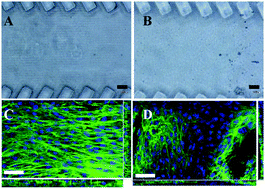Scalable alignment of three-dimensional cellular constructs in a microfluidic chip†
Abstract
There have been considerable efforts to engineer three-dimensional (3D) microfluidic environments to enhance cellular function over conventional two-dimensional (2D) cultures in microfluidic chips, but few involve topographical features, such as micro/nano-grooves, which are beneficial for cell types of cardiac, skeletal and neuronal lineages. Here we have developed a cost-effective and scalable method to incorporate micro-topographical cues into microfluidic chips to induce cell alignment. Using commercially available optical media as molds for


 Please wait while we load your content...
Please wait while we load your content...